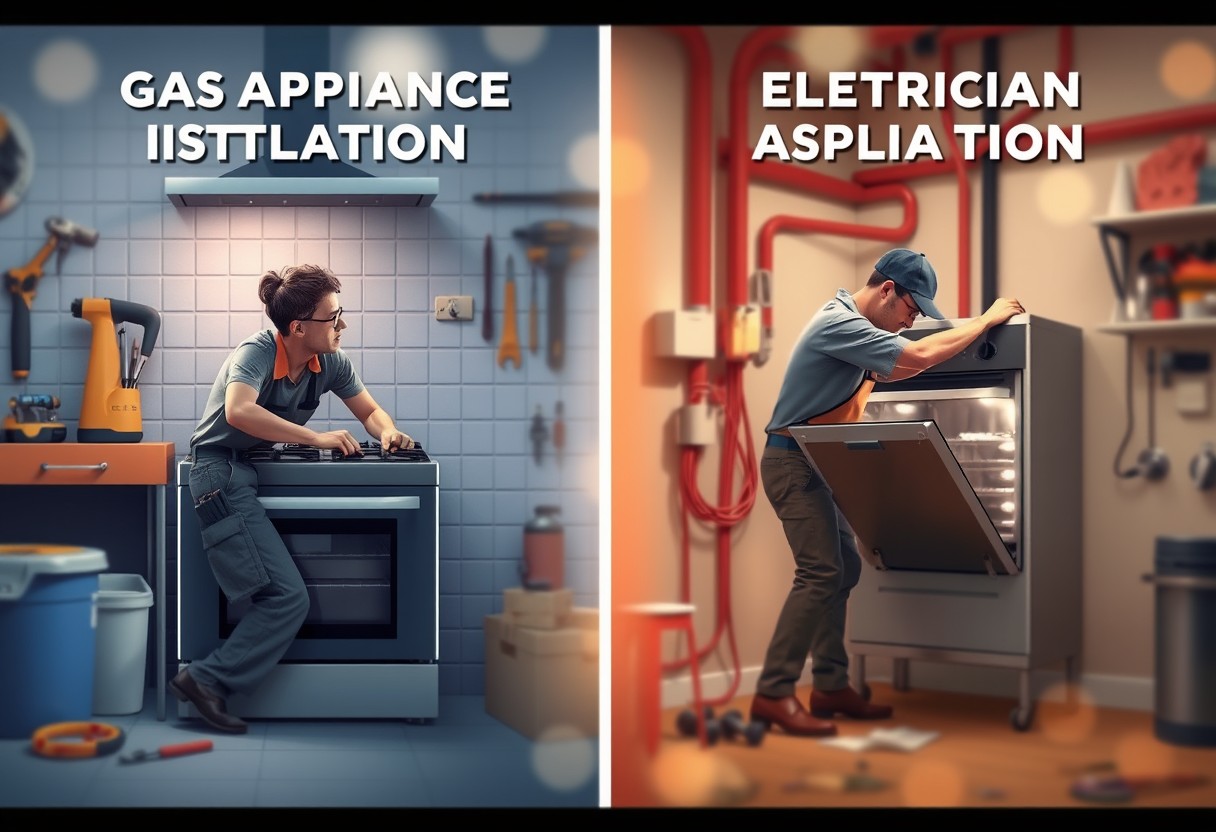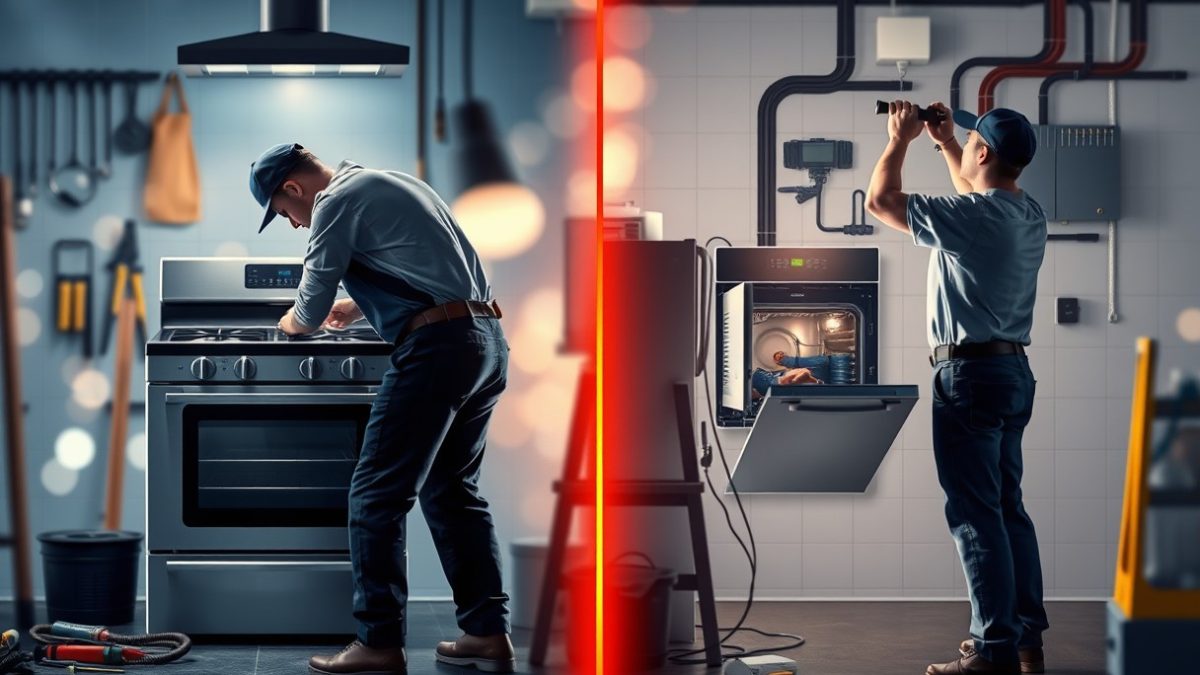
How Do Gas Appliance Installations Elevate Home Efficiency And Safety?
September 10, 2024
Can You Identify The Key Components Of Product Support For Home Appliances?
September 12, 2024There’s a significant difference in the complexity of gas and electrical appliance installations that you should understand to ensure safety and efficiency in your home. When dealing with gas appliances, you face potential hazards like leaks or explosions if not installed correctly, while electrical installations come with risks of shock or fire if improperly executed. This blog post will guide you through the critical aspects of each type of installation, helping you make informed decisions whether you’re a DIY enthusiast or considering professional assistance.
Key Takeaways:
- Installation Requirements: Gas appliance installations often require compliance with stringent safety regulations and local codes, while electrical installations also have guidelines but can be more straightforward.
- Tools and Skills: Gas installations may need specialized tools and certifications, whereas electrical installations usually require knowledge of wiring practices and circuit regulations.
- Maintenance and Safety: Gas appliances pose potential hazards such as leaks and carbon monoxide, necessitating regular checks, while electrical appliances focus more on ensuring proper grounding and circuit integrity.
Understanding Gas Appliance Installations
Overview of Gas Appliances
One of the primary distinctions in household utility systems is the use of gas appliances, which rely on natural gas or propane for their operation. These appliances are common in many homes, providing crucial functions like heating, cooking, and hot water. From gas stoves to furnaces, understanding these devices is critical for safety and efficiency.
Gas appliances often offer a few advantages over their electric counterparts, such as quicker heating times and potentially lower energy costs. However, with these benefits come additional complexities in installation and maintenance that require specialized knowledge and skills.
Key Components of Gas Appliance Systems
Appliance installations typically involve several critical components, including regulators, valves, burners, and venting systems. Each of these parts plays a pivotal role in ensuring that your appliance functions correctly and safely. Understanding these components is crucial for any homeowner considering gas installations.
The regulator is a vital part that controls the gas pressure, while the valve allows you to shut off the gas supply when necessary. Furthermore, the burner is where gas ignites to produce heat, and the venting system ensures that any harmful gases produced during combustion are safely expelled from your home. Proper installation and maintenance of these components are key to preventing dangerous situations.
Safety Protocols and Regulations
Overview of gas appliance installations requires you to be aware of pertinent safety protocols and regulations. You must ensure compliance with local building codes, which specify how gas lines should be run and how appliances should be installed. These regulations are designed to reduce risks, like gas leaks or fires, which can have dire consequences.
Adhering to these regulations not only helps keep your home and family safe but can also influence your insurance coverage. Homeowners are often required to provide proof of professional installation to fulfill policy requirements.
Plus, you should take proactive steps to stay educated about your local gas codes and any changes that may occur over time. Regular inspections by certified professionals will ensure that your gas installation remains in compliance with current safety standards, protecting your home and its occupants.
Installation Process: Step-by-Step Guide
One must navigate through a multi-step process for a successful gas appliance installation. The following table outlines the primary steps involved:
| Step | Description |
|---|---|
| 1 | Assessment of Installation Site |
| 2 | Choosing the Right Gas Appliance |
| 3 | Preparing the Gas Lines |
| 4 | Connecting the Appliance |
| 5 | Testing for Leaks |
| 6 | Final Inspection and Operation Check |
Installation of gas appliances requires careful attention to these steps to ensure a smooth and safe process. Missing any of these critical phases can lead to functionality issues or increased safety hazards.
Common Challenges and Troubleshooting
Guide your efforts by being aware of common challenges you may face during gas appliance installations. Issues can arise from pre-existing gas lines that are outdated or non-compliant with the current standards. Further complications can include inadequate ventilation or incorrect appliance sizing, which can impact efficiency and safety significantly.
Additionally, you should be prepared for troubleshooting after installation. Problems with ignition, gas odors, or irregular burner flames can arise, requiring prompt attention from skilled professionals. Addressing these issues swiftly is important to ensure your safety and the proper functioning of the appliances.
Understanding these challenges will equip you with the knowledge to handle potential issues effectively. Proper caretaker measures and proactive maintenance can prevent many common problems associated with gas appliances, contributing to a safer and more efficient household.

Understanding Electrical Appliance Installations
Now, when it comes to electrical appliances, understanding their installation is crucial for both safety and functionality. These systems are often complex and require a level of expertise to ensure that they operate efficiently and do not pose a hazard to you or your home. Missteps in electrical installation can lead to a variety of issues, from minor inconveniences to severe electrical fires.
Overview of Electrical Appliances
Electrical appliances are devices that utilize electricity to perform specific tasks. These range from large household appliances like refrigerators, ovens, and washing machines to smaller devices such as microwaves, toasters, and hairdryers. Understanding what constitutes an electrical appliance is key to approaching their installation properly. Each type has its own set of requirements and installation guidelines, which must be adhered to during the setup process.
Key Components of Electrical Systems
One of the fundamental aspects of electrical installations involves understanding the key components of electrical systems. These consist of wiring, circuit breakers, switches, and outlets, among others. Proper knowledge of each component allows you to troubleshoot and maintain your electrical appliances effectively. Furthermore, it is vital to ensure that all parts are compatible with the appliance you are installing to avoid electrical hazards.
Overview of the key components reveals that wiring serves as the backbone of your electrical system. Circuit breakers are critical for preventing overloads, while switches and outlets facilitate user interaction. Installing these components correctly is vital for the overall safety and performance of your electrical appliances.
Safety Protocols and Regulations
Electrical safety protocols and regulations are designed to ensure that installations comply with national and local codes. Familiarizing yourself with these regulations is vital when working with electrical appliances. All installations must adhere to guidelines that cover everything from wiring methods to grounding requirements, ensuring that your appliances are installed safely.
Understanding which regulations apply to your installation can prevent electrical mishaps that may endanger you and your property. Compliance isn’t just about following rules but about safeguarding your home and ensuring the longevity of your appliances.
Installation Process: Step-by-Step Guide
Electrical installations can be methodical processes, often broken down into manageable steps. You should follow a step-by-step guide tailored to your specific appliance. Below is a simplified version of an installation guide that outlines key progressions in getting your appliance ready for use.
| Step | Description |
|---|---|
| 1 | Read the appliance manual thoroughly. |
| 2 | Ensure that the power supply is turned off prior to installation. |
| 3 | Secure necessary tools and materials for installation. |
| 4 | Install the vital components (outlets, wiring, etc.) as per guidelines. |
| 5 | Test the installation for safety and proper operation. |
It is important that you always refer to the manufacturer’s instructions to ensure your installation is tailored to the specific appliance. If at any point you feel uncertain about your understanding of the wiring or installation process, consider hiring a professional electrician.
Common Challenges and Troubleshooting
Electrical installations can come with their own set of challenges. Electrical issues may manifest in various ways, such as flickering lights, tripped circuit breakers, or even non-functioning appliances. Recognizing these signs early on can help you avoid larger, more expensive problems down the line.
Common challenges include incorrect wiring, faulty circuit breakers, and not meeting local electrical codes. This can lead to issues that not only hinder the performance of your appliances but can also be dangerous. Utilizing the troubleshooting techniques shared in your appliance manual will aid you in addressing these problems quickly and efficiently.
Common problems can stem from a lack of understanding of the electrical system in your home. Being proactive and knowledgeable can significantly reduce the risk of encountering serious issues during your appliance installation.
Comparing Complexity: Gas vs. Electrical Installations
After considering the various factors involved in gas and electrical installations, it’s clear that each has its own complexities and challenges. Below is a comparison that highlights key aspects of both installations.
| Aspect | Gas Installations | Electrical Installations |
|---|---|---|
| Technical Skill Requirements | Higher level of understanding of gas-related systems | Generally requires a solid understanding of electrical circuits |
| Regulatory Compliance Demands | More stringent due to potential hazards | Less stringent but still requires adherence to safety standards |
| Safety Considerations | Requires consideration of gas leaks and combustion safety | Concerns over electrical shock and fire hazards |
| Tools and Equipment Needed | Specialized tools for gas fittings and leak detection | Tools for wiring, circuit testing, and voltage measurement |
| Time Investment for Installation | Potentially longer due to complexity of gas systems | Can often be completed in a shorter time frame |
Technical Skill Requirements
An effective gas installation requires a higher level of understanding regarding how gas systems operate. This includes knowledge of pressure regulations, venting requirements, and how to safely handle gas line connections. Gas installations are not only about fitting pipes but ensuring that you follow strict safety protocols to mitigate any potential risks associated with leaks and combustion.
On the other hand, electrical installations necessitate a solid grasp of electrical circuits, material properties, and wiring techniques. While they may appear simpler, the potential for dangers such as short circuits or electrocution mean that understanding electrical systems is crucial for ensuring safety and compliance.
Regulatory Compliance Demands
Technical compliance is a cornerstone of gas installations and tends to be more stringent. This is largely due to the inherent risks associated with gas leaks, appetite for fire hazards, and the implications of improper installation. Various regulations dictate the way gas systems must be installed, maintained, and inspected.
The requirements for electrical installations, while also significant, are generally less complex. However, you must still adhere to local electrical codes and standards to ensure safety and functionality. Failing to follow these regulations could result in severe consequences, including fines, damage to property, or even injury.
Safety Considerations
The safety considerations in gas installations are extensive. You need to be particularly vigilant about **preventing gas leaks**, which can lead to explosions or suffocation. Understanding how to properly test for leaks and ensure all fittings are secure is vital to avoid these dangers.
In contrast, the **safety considerations for electrical installations** focus on preventing electrical shock and fire risks. Working with live wires and understanding the implications of circuit overloads is crucial in this field. Familiarizing yourself with safety measures such as circuit breakers and grounding can help mitigate potential hazards.
Requirements for gas installations often include comprehensive training in identifying and rectifying hazards associated with gas appliances, while electrical installations focus on electrical code familiarity and effective troubleshooting techniques.
Tools and Equipment Needed
Electrical installations require specific tools that focus on wiring, circuit testing, and voltage measurement. You’ll need a multimeter, wire strippers, and screwdrivers among other tools that help in effectively and safely completing your installation. Precision is key, emphasizing the importance of using the right tools to avoid pitfalls during electrical work.
When dealing with gas installations, you’ll also need a set of specialized tools designed for gas fittings and leak detection. Using the appropriate tools ensures that you maintain safety standards while effectively completing your installation task.
Time Investment for Installation
Equipment installations can vary significantly in the time required based on the complexity of the system. Gas installations may take longer due to the various safety checks and regulatory compliance that must be addressed. This extends the installation timeline as you ensure every step complies with legal requirements.
In many cases, electrical installations are completed in a shorter time frame due to their relative simplicity compared to gas installations. However, unexpected complications can arise that may also prolong the process. It’s vital that you allocate sufficient time to troubleshoot and rectify these issues during the installation phase.
Installation time is often influenced by numerous factors such as the experience of the technician, the intricacy of the system being installed, and unforeseen challenges that may occur along the way.
Cost Analysis of Gas and Electrical Installations
Many homeowners consider both initial installation costs and long-term maintenance expenses when deciding between gas and electrical appliance installations. Understanding these financial aspects can help you make informed choices that fit your budget while meeting your energy needs.
Initial Installation Costs
Any installation involves upfront expenses, which can vary significantly between gas and electrical systems. Generally, gas installations tend to be more expensive initially due to the necessity of professional installation for safety, which includes venting and gas line connections. You may need specific tools and materials that can raise the cost of installation.
In contrast, the costs associated with electrical installations might be lower since the work is often simpler and can sometimes be performed by DIY enthusiasts. However, if your electrical system requires significant upgrades or if you’re installing multiple high-wattage appliances, the costs can quickly add up, potentially equalizing the price with gas installations.
Long-term Maintenance Costs
On the other hand, long-term maintenance costs are an necessary consideration in any installation decision. Gas systems typically require regular inspections to ensure safe operation, which can incur additional costs over time. Household gas leaks, if not detected early, can pose serious safety risks and require emergency repairs. As a gas appliance ages, maintenance may be necessary to keep it functioning efficiently.
Electrical appliances also have their share of maintenance costs, but these may be less intensive overall. Issues such as faulty wiring or circuit problems can arise in older homes, which may necessitate professional inspections and repairs. Overall, an electrically-powered appliance could be less prone to breakdown than a gas appliance, potentially saving you money in the long run.
Installation of appliances will depend significantly on the particular appliance type and brand you choose. Although each system has its own advantages and unique maintenance needs, your budgetary considerations may play a key role in deciding on gas or electric solutions.
Energy Efficiency and Operating Costs
With energy efficiency becoming a priority for many consumers, it’s vital to consider the operating costs associated with both gas and electric appliances. Generally, gas appliances are often more efficient in terms of energy output. However, electrical appliances can sometimes convert a higher percentage of energy into usable power, particularly with modern technology. Therefore, while your initial costs may vary, your operating costs could significantly affect your overall financial picture.
Over time, the cost of energy itself will also impact your operating expenses. With fluctuating energy prices, you may want to monitor the market to make an informed decision about which system will save you more in the long term.
Financing Options
Options abound when it comes to financing your appliance installation. Many companies offer various financing plans, including low-interest loans and installment payments to accommodate your budget and make the transition smoother. By doing your research, you can find financing options that allow for manageable monthly payments without compromising on quality.
Access to grants or rebates might also be available for energy-efficient appliances that can further alleviate the burden of installation costs. By exploring these financial assistance options, you can make a more economical choice while upgrading your home’s energy setup.
Analysis of your project will require careful consideration of the details discussed, including initial costs, maintenance expenses, operating efficiency, and financing options. Taking all these factors into account offers you greater clarity on which installation type best suits your needs and financial situation.

Advantages and Disadvantages of Each Type
All homeowners face the challenge of choosing the right appliances for their needs, which often leads to considering gas and electrical options. Both types have their unique advantages and disadvantages, making your choice dependent on various factors such as efficiency, installation complexity, and safety.
Benefits of Gas Appliance Installations
Installations of gas appliances are often preferred for their efficiency and cost-effectiveness. Gas appliances, such as stoves and water heaters, tend to heat up more quickly and provide instant heat, which can lead to significant energy savings in the long run. Additionally, many gas appliances operate at a lower cost compared to their electric counterparts, which can translate to reduced monthly utility bills.
Another significant benefit of gas appliances is their reliability during power outages. If you live in an area prone to blackouts, you can continue cooking or heating water without interruption, providing peace of mind. This is particularly useful for those who enjoy cooking and don’t want to compromise their meal plans due to electrical issues.
Drawbacks of Gas Appliance Installations
To every advantage, there are corresponding drawbacks. One major concern with gas appliance installations is the risk of gas leaks, which can pose serious safety hazards, including fires and explosions. Proper installation and regular maintenance are crucial to ensuring safety, but this adds an additional layer of responsibility for homeowners.
Additionally, gas appliances often require ventilation systems to handle combustion byproducts, which can complicate installation and may involve additional costs and planning. Retrofits can be costly if your home is not already equipped with proper venting, making it necessary to evaluate the feasibility of such installations.
Appliance safety is paramount, and with gas systems, you must ensure that they are regularly monitored and maintained. Malfunctions due to improper installations or neglect can lead to severe consequences, underscoring the need for professional assistance with any installations.
Benefits of Electrical Appliance Installations
Appliance installations that use electricity are lauded for their convenience and ease of use. Modern electric appliances are often equipped with advanced features, making them user-friendly and often more efficient. With the option of smart technology, you can control your electric appliances remotely, enhancing your daily life and allowing for greater flexibility.
Moreover, electric appliances typically require less maintenance than gas appliances. They do not involve combustion, which reduces the risk of leaks and associated safety hazards. This simplifies installation as well since they usually do not require extensive venting systems, making them suitable for various settings, including homes without existing gas lines.
Type of appliances can make a significant difference; electric options are often perceived as safer due to the lack of flammable gas. Furthermore, with the growing emphasis on renewable energy sources, electric appliances can align better with eco-friendly practices as they can be powered by solar or wind energy, contributing to sustainability efforts.
Drawbacks of Electrical Appliance Installations
Any advantage comes with its share of challenges. One of the primary drawbacks of electrical appliance installations is the dependence on electricity. If you experience a power outage, your electric appliances will be rendered useless until power is restored, which can be particularly inconvenient in regions with unstable power supply.
Additionally, the installation and operational costs of electrical appliances may be higher in some cases. Electric models may consume more energy than gas counterparts, leading to higher utility expenses over time, especially with high-demand appliances such as water heaters and dryers.
Advantages of choosing the right appliance installation are paramount. You must weigh the benefits against the drawbacks for both gas and electric models, ensuring you prioritize safety, efficiency, and suitability for your lifestyle. By doing so, you will make an informed decision that aligns with your home and your needs.
Environmental Impact and Sustainability
Once again, understanding the environmental impact of your home appliances is crucial, especially when comparing gas and electrical installations. While both options have their pros and cons, knowing how they stack up in terms of sustainability, efficiency, and emissions can help you make a more informed decision.
Emissions from Gas Appliances
Sustainability is a major concern when it comes to gas appliances, as they emit carbon dioxide and other harmful byproducts during combustion. These emissions contribute to air pollution and climate change, affecting both your health and the environment. Moreover, gas leaks are not just an efficiency issue; they also pose significant safety risks and can result in increased greenhouse gas emissions, making your gas appliances less sustainable over time.
Environmental Footprint of Electrical Appliances
Emissions from electrical appliances primarily depend on the source of the electricity used to power them. If your electricity comes from renewable sources, such as solar or wind, your environmental footprint is considerably lower than when it is derived from fossil fuels. However, one can’t ignore the fact that the manufacturing process of electrical appliances often requires substantial energy and resources, adding to their overall environmental footprint.
Environmental awareness has risen, leading many manufacturers to look for ways to reduce the impact of electrical appliance production. For example, they are increasingly focused on creating energy-efficient devices that consume less electricity, thereby reducing emissions in the long term. You can play a significant role by opting for high-efficiency models that comply with sustainability standards.
Sustainability in Installation Practices
For anyone planning to install new appliances, understanding the sustainability of installation practices is crucial. Proper installation can not only ensure that your appliances function effectively but can also reduce unnecessary waste and energy consumption. Utilizing eco-friendly materials and adhering to best practices can maximize the overall efficiency of both gas and electrical appliances, helping you achieve a lower environmental impact.
From ensuring proper venting to utilizing efficient piping and wiring, your installation choices can greatly influence the sustainability of your appliances. A well-executed installation can prevent leaks and energy waste, making it important to consult with qualified professionals who prioritize sustainable practices.
Future Trends in Appliance Technology
Trends in appliance technology are leaning towards increased efficiency and sustainability. As consumer awareness grows around environmental issues, manufacturers are developing innovations that not only provide conveniences but also minimize their ecological impact. You’ll notice features such as smart technology, which allows you to control energy usage more effectively, becoming more prevalent in new electrical appliances.
Installation of these advanced devices often involves higher upfront costs but can lead to long-term savings and environmental benefits. By investing in modern technology now, you might find that your appliances significantly enhance both the usability and sustainability of your home.
Installation plays a critical role in maximizing these new efficiencies. Proper setup of smart appliances, for instance, can contribute to their energy-saving functionalities, reinforcing the importance of skilled installation practices. Always consider investing in trained professionals for installation to ensure you are getting the most out of your eco-friendly appliance choices.
To wrap up
Presently, understanding the complexities of gas and electrical appliance installations is crucial for any homeowner or professional in the field. You should recognize that gas installations often require a deeper understanding of safety protocols, as they involve dealing with combustible materials and potential hazards associated with gas leaks. This necessitates specialized training and certification to ensure that you adhere to local codes and regulations. Conversely, while electrical installations also demand knowledge and compliance with safety standards, many homeowners might find them to be more straightforward due to the abundance of instructional resources available.
Ultimately, whether you are installing gas or electrical appliances, the key to a successful installation lies in understanding the unique challenges each type presents. You must evaluate your own expertise and comfort level with these systems and consider hiring professionals when necessary. By navigating these complexities with care, you can ensure that your appliances operate safely and efficiently, contributing to the overall functionality of your home. Always prioritize safety, whether you are working with gas or electricity.
FAQ
Q: What are the key differences in the installation process for gas appliances versus electrical appliances?
A: The installation process for gas appliances typically involves more complexity due to the need for proper ventilation, gas line connection, and adherence to specific safety regulations. Gas appliances may require a licensed plumber or gas technician to install the gas lines and ensure there are no leaks. On the other hand, electrical appliances often require only basic electrical connections, which can sometimes be performed by the homeowner if they have the right skills. However, both installations must comply with local building codes and safety standards.
Q: Are there safety considerations that make gas appliance installations more complex than electrical appliance installations?
A: Yes, the safety considerations are one of the main factors that add complexity to gas appliance installations. Gas appliances pose a risk of leaks, which can lead to severe hazards such as explosions or carbon monoxide poisoning. Therefore, proper testing and certified installations are mandatory. Additionally, gas appliances require ventilation to ensure that any combustion gases are safely expelled outside. In contrast, while electrical installations also have safety risks, they generally focus on proper wiring and circuit load management, which tends to be more straightforward.
Q: Is it more costly to install gas appliances compared to electrical appliances?
A: In general, the installation cost for gas appliances can be higher than for electrical appliances due to the additional labor and materials needed to safely connect gas lines and ensure proper ventilation. The need for specialized skills from licensed professionals can also drive up costs. Moreover, costs may vary significantly based on local codes and the specific appliance being installed. However, some electrical appliances, such as high-powered systems, may also incur significant installation costs. Therefore, it’s vital to assess the requirements on a case-by-case basis to determine the overall expense.

